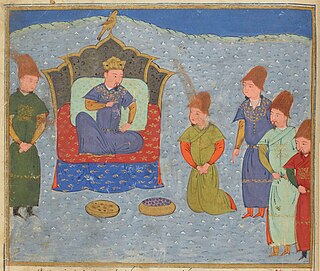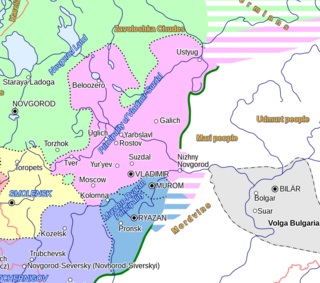
Year 1238 (MCCXXXVIII) was a common year starting on Friday of the Julian calendar.

Year 1237 (MCCXXXVII) was a common year starting on Thursday of the Julian calendar.

The Mongol Empire invaded and conquered much of Kievan Rus' in the mid-13th century, sacking numerous cities including the largest such as Kiev and Chernigov. The Mongol siege and sack of Kiev in 1240 is generally held to mark the end of Kievan Rus' as a distinct, singular polity. Many other Rus' principalities and urban centres in the northwest and southwest escaped destruction or suffered little to no damage from the Mongol invasion, including Galicia-Volhynia, Novgorod, Pskov, Smolensk, Polotsk, Vitebsk, and probably Rostov and Uglich.

Batu Khan was a Mongol ruler and founder of the Golden Horde, a constituent of the Mongol Empire. Batu was a son of Jochi, thus a grandson of Genghis Khan. His ulus ruled over the Kievan Rus', Volga Bulgaria, Cumania, and the Caucasus for around 250 years.

Vladimir-Suzdal, formally known as the Principality of Vladimir-Suzdal or Grand Principality of Vladimir (1157–1331), also as Vladimir-Suzdalian Rus', was one of the major principalities that succeeded Kievan Rus' in the late 12th century, centered in Vladimir-on-Klyazma. With time the principality grew into a grand principality divided into several smaller principalities. After being conquered by the Mongol Empire, the principality became a self-governed state headed by its own nobility. A governorship of principality, however, was prescribed by a jarlig issued from the Golden Horde to a Rurikid sovereign.

Yuri II, also known as George II of Vladimir or as Georgy II Vsevolodovich, was the fourth Grand Prince of Vladimir who presided over the Principality of Vladimir-Suzdal at the time of the Mongol invasion of Kievan Rus'.

Michael of Chernigov or Mikhail Vsevolodovich ; c. 1185 – 20 September 1246) was Grand Prince of Kiev ; he was also Prince of Pereyaslavl (1206), Prince of Novgorod-Seversk (1219–1226), Prince of Chernigov, Prince of Novgorod, and Prince of Galicia (1235–1236).

From the 1220s into the 1240s, the Mongols conquered the Turkic states of Volga Bulgaria, Cumania and Iranian state of Alania, and various principalities in Eastern Europe. Following this, they began their invasion into Central Europe by launching a two-pronged invasion of then-fragmented Poland, culminating in the Battle of Legnica, and the Kingdom of Hungary, culminating in the Battle of Mohi. Invasions were also launched into the Caucasus against the Kingdom of Georgia, the Chechens, the Ingush, and Circassia though they failed to fully subjugate the latter. More invasions were launched in Southeast Europe against Bulgaria, Croatia, and the Latin Empire. The operations were planned by General Subutai (1175–1248) and commanded by Batu Khan and Kadan, two grandsons of Genghis Khan. Their conquests integrated much of Eastern European territory into the empire of the Golden Horde. Warring European princes realized they had to cooperate in the face of a Mongol invasion, so local wars and conflicts were suspended in parts of central Europe, only to be resumed after the Mongols had withdrawn. After the initial invasions, subsequent raids and punitive expeditions continued into the late 13th century.

The Battle of the Sit River took place on 4 March 1238 between the Mongol hordes of Batu Khan and the Suzdalians under Grand Prince Yuri II of Vladimir-Suzdal during the Mongol invasion of Kievan Rus'. It was fought in the northern part of the present-day Sonkovsky District of Tver Oblast of Russia, close to the selo of Bozhonka.

The Siege of Ryazan happened Ryazan in December 1237 during the Mongol invasion of Kievan Rus'. Ryazan, capital of the Principality of Ryazan, was the first Kievan Rus' city to be besieged by the Mongol invaders under Batu Khan.
Boroldai, also known as Burundai, was a notable Mongol general of the mid 13th century. He participated in the Mongol invasion of Russia and Europe in 1236-1242 and other Mongol raids to Europe until 1263.
The Tale of the Destruction of Ryazan (by Batu) (Russian: Повесть о разорении Рязани Батыем, romanized: Povest' o razorenii Riazami Batyem) is a Russian literary work about the capture of the city of Ryazan by the Mongols in 1237. It is compiled from earlier manuscripts.

Furious, also known as Legend of Kolovrat, is a 2017 Russian epic period action film directed by Dzhanik Fayziev and Ivan Shurkhovetsky. The film stars newcomer Ilya Malakov as the legendary Ryazan bogatyr Evpaty Kolovrat, as well as Polina Chernyshova, Aleksei Serebryakov, Aleksandr Ilyin Jr. and Yulia Khlynina in supporting roles.

Yury or Yuri Ingvarevich also known as Yuri Igorevich, was Grand Prince of Ryazan from 1235 until his death in 1237 during the siege of Ryazan as part of the Mongol invasions.
The Siege of Kolomna during December 1237–January 1238 was part of the Mongol invasion of Kievan Rus'. Following the Battle of Voronezh River in December 1237, Yuri II of Vladimir sent both of his sons with "all his men" and Voivode Yeremey to defend the fortress of Kolomna, which was on the border to the Wild Fields.

The siege of Vladimir in February 1238 was part of the Mongol invasion of Kievan Rus'.
The siege of Moscow in January 1238 was part of the Mongol invasion of Kievan Rus'.
The Mongol siege, capture and sack of Chernigov, capital of the Chernigov Principality, occurred on 18 October 1239 during the westward expansion of the Mongol Empire. It was part of the 1237–1242 Mongol invasion of Kievan Rus'.
The armies of the Rus' principalities emerged in the 13th century out of the military of Kievan Rus', shattered by the Mongol invasion of Kievan Rus'. The princely Rus' armies from 1240 to 1550 were characterised by feudalism, consisting of cavalry armies of noble militia and their armed servants.

The military of Kievan Rus' served as the armed forces of Kievan Rus' between the 9th to 13th century. It was mainly characterised by infantry armies of town militia that were supported by druzhyna cavalry.










